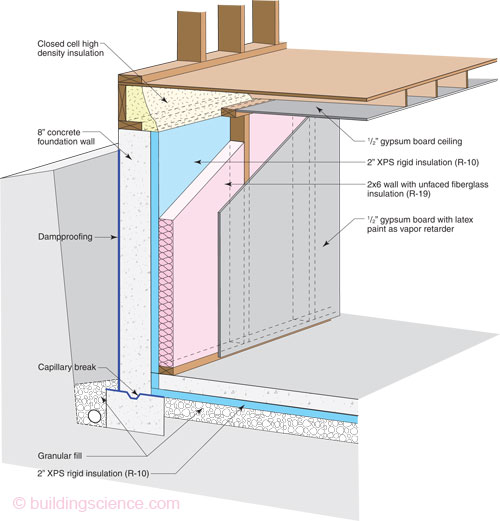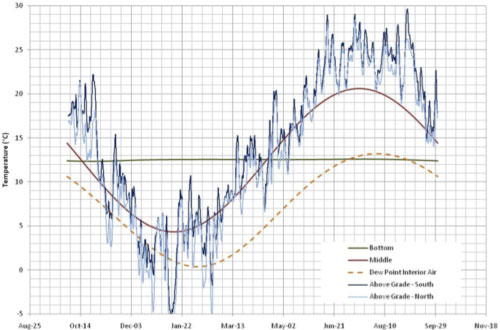This construction uses 2" XPS rigid insulation against the concrete foundation and a 2x6 framed wall with R-19 unfaced fiberglass insulation in the stud space. The slab is insulated with 2" XPS rigid insulation under slab and the rim joist is insulated with closed cell high density spray foam insulation.

Foundation Wall
- Free draining backfill
- Dampproofing to grade
- Concrete foundation wall (over a capillary break on the concrete footing)
- 2" XPS rigid insulation
- 2x6 frame wall with R-19 unfaced fiberglass cavity insulation
- Interior gypsum wall board with vapor retarder paint
Foundation Slab
- Concrete foundation slab
- 6 mil polyethylene vapor barrier under slab
- 2" XPS rigid insulation under slab
- 4” stone pad (no fines)
- Undisturbed/ native soil
Thermal Control
This foundation wall system has a calculated parallel path R-value of R-28.7, and a yearly heating energy consumption of 14.79 MBTus assuming R-10 under the slab and in the thermal break. Only if the rest of the enclosure is super insulated, and airtight, in a very cold climate will it make sense to increase the R-value of the foundation wall. It may make sense with an R-30 foundation wall to increase the underslab insulation to R-15 or R-20. This should be examined in more detail.
Moisture Control
This wall was analyzed in WUFI to predict the moisture related risk in the wall system, and it was shown that the RH at the surface of the XPS in the above grade portion of the wall is elevated in the winter months (Figure 2), and that there is some condensation potential alternating with periods of drying potential at the top of the foundation wall. (Figure 3). There is little risk of moisture related issues in this all system if the interior RH is controlled with a dehumidifier, and the interior drywall is well air sealed.
Figure 2: Predicted RH at the interior surface of the XPS
Figure 3: Interior air leakage condensation potential
Constructability and Cost
This wall system is slightly more expensive than High-R Foundation 8 and High-R Foundation 9 by increasing the depth of the framed cavity with 2x6 framing instead of 2x4 framing. It is possible to use 2x4 framing stood out from the XPS by 2 inches, and use R-19 fiberglass batts, or blown cellulose or fiberglass. R-19 fiberglass batts should be less expensive than R-13 fiberglass batts because the manufacturing process for both R-19 and R-13 batts uses the same amount of fibreglass, but the R-13 batts require more time and effort to compact to 31/2” making them more expensive to produce.
Other Considerations
None noted.
Reference
Mitalas, G.P., Calculation of Basement Heat Loss, National Research Council Canada.


